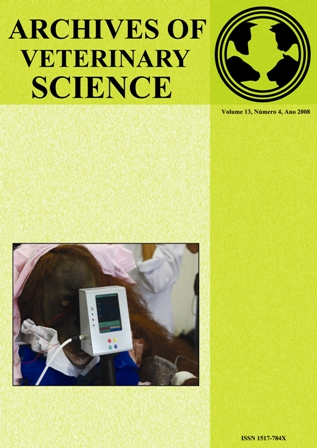BIOECOLOGIA DOS DIFERENTES ESTADIOS DE D. hominis (LINNAEUS Jr., 1781) CRIADOS COM DIFERENTES SUBSTRATOS EM CONDIÇÕES DE LABORATÓRIO
DOI:
https://doi.org/10.5380/avs.v13i4.15276Palavras-chave:
Dermatobia hominis, larvas, ciclo biológicoResumo
Larvas de Dermatobia hominis foram colhidas, de animais naturalmente infestados, e tratadas em condições de laboratório com a finalidade de reproduzir seu ciclo biológico. Com o desenvolvimento de todos os estádios da D. hominis em laboratório, desde a postura dos ovos até a formação de um novo imago, tornar-se-á possível a avaliação das condições para a sobrevivência de cada estádio, o que poderia contribuir no desenvolvimento de novas técnicas para o seu controle. Foram testados diferentes meios substratos para o desenvolvimento, compostos por terra, areia e serragem. Os diferentes meios empregados para o desenvolvimento de pupa de D. hominis foram considerados satisfatórios, porém, estatisticamente distintos (P<0,05). O tratamento composto por serragem e areia, foi o meio mais adequado, por ter apresentado desenvolvimento de 54% das larvas L3 em pupas e 62% destas em adultos de D. hominis, sendo 79% machos e 41% fêmeas. A vida média dos adultos também variou de acordo com o sexo, sendo que 49% dos machos apresentaram uma vida média de 5 dias, já 70% das fêmeas apresentaram uma vida média entre 8 e 9 dias.
Downloads
Como Citar
Edição
Seção
Licença
Autores que publicam nesta revista concordam com os seguintes termos:
- Autores mantém os direitos autorais e concedem à revista o direito de primeira publicação, com o trabalho simultaneamente licenciado sob a Creative Commons - Atribuição 4.0 Internacional que permite o compartilhamento do trabalho com reconhecimento da autoria e publicação inicial nesta revista.
- Autores têm autorização para assumir contratos adicionais separadamente, para distribuição não-exclusiva da versão do trabalho publicada nesta revista (ex.: publicar em repositório institucional ou como capítulo de livro), com reconhecimento de autoria e publicação inicial nesta revista.
- Autores têm permissão e são estimulados a publicar e distribuir seu trabalho online (ex.: em repositórios institucionais ou na sua página pessoal) a qualquer ponto antes ou durante o processo editorial, já que isso pode gerar alterações produtivas, bem como aumentar o impacto e a citação do trabalho publicado.














